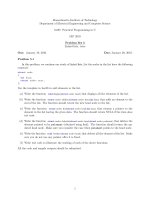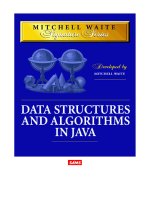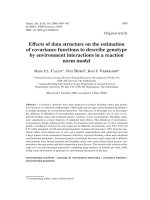Data structure linked lists
Bạn đang xem bản rút gọn của tài liệu. Xem và tải ngay bản đầy đủ của tài liệu tại đây (655.91 KB, 68 trang )
Starting Out with C++, 3
rd
Edition
1
Data structure Linked Lists
Starting Out with C++, 3
rd
Edition
2
17.1 Introduction to the Linked
List ADT
•
A linked list is a series of connected nodes,
where each node is a data structure.
•
A linked list can grow or shrink in size as
the program runs
Starting Out with C++, 3
rd
Edition
3
Advantages of Linked Lists
over Arrays and vectors
•
A linked list can easily grow or shrink in
size.
•
Insertion and deletion of nodes is quicker
with linked lists than with vectors.
Starting Out with C++, 3
rd
Edition
4
The composition of a Linked
List
•
Each node in a linked list contains one or
more members that represent data.
•
In addition to the data, each node contains a
pointer, which can point to another node.
Starting Out with C++, 3
rd
Edition
5
The composition of a Linked
List
•
A linked list is called "linked" because each
node in the series has a pointer that points
to the next node in the list.
Starting Out with C++, 3
rd
Edition
6
Declarations
•
First you must declare a data structure that
will be used for the nodes. For example, the
following struct could be used to create
a list where each node holds a float:
struct ListNode
{
float value;
struct ListNode *next;
};
Starting Out with C++, 3
rd
Edition
7
Declarations
•
The next step is to declare a pointer to serve
as the list head, as shown below.
ListNode *head;
•
Once you have declared a node data
structure and have created a NULL head
pointer, you have an empty linked list.
•
The next step is to implement operations
with the list.
Starting Out with C++, 3
rd
Edition
8
17.2 Linked List Operations
•
We will use the following class declaration (on the
next slide), which is stored in FloatList.h.
Starting Out with C++, 3
rd
Edition
9
class FloatList
{
private:
// Declare a structure for the list
struct ListNode
{
float value;
struct ListNode *next;
};
ListNode *head; // List head pointer
public:
FloatList(void) // Constructor
{ head = NULL; }
~FloatList(void); // Destructor
void appendNode(float);
void insertNode(float);
void deleteNode(float);
void displayList(void);
};
Starting Out with C++, 3
rd
Edition
10
Appending a Node to the List
•
To append a node to a linked list means to add the node to
the end of the list.
•
The pseudocode is shown below. The C++ code follows.
Create a new node.
Store data in the new node.
If there are no nodes in the list
Make the new node the first node.
Else
Traverse the List to Find the last node.
Add the new node to the end of the list.
End If.
Starting Out with C++, 3
rd
Edition
11
void FloatList::appendNode(float num)
{
ListNode *newNode, *nodePtr;
// Allocate a new node & store num
newNode = new ListNode;
newNode->value = num;
newNode->next = NULL;
// If there are no nodes in the list
// make newNode the first node
if (!head)
head = newNode;
else // Otherwise, insert newNode at end
{
// Initialize nodePtr to head of list
nodePtr = head;
// Find the last node in the list
while (nodePtr->next)
nodePtr = nodePtr->next;
// Insert newNode as the last node
nodePtr->next = newNode;
}
}
Starting Out with C++, 3
rd
Edition
12
Program 17-1
// This program demonstrates a simple append
// operation on a linked list.
#include <iostream.h>
#include "FloatList.h”
void main(void)
{
FloatList List;
list.appendNode(2.5);
list.appendNode(7.9);
list.appendNode(12.6);
}
(This program displays no output.)
Starting Out with C++, 3
rd
Edition
13
Stepping Through the Program
•
The head pointer is declared as a global variable.
head is automatically initialized to 0 (NULL),
which indicates that the list is empty.
•
The first call to appendNode passes 2.5 as the
argument. In the following statements, a new node
is allocated in memory, 2.5 is copied into its
value member, and NULL is assigned to the
node's next pointer.
Starting Out with C++, 3
rd
Edition
14
newNode = new ListNode;
newNode->value = num;
newNode->next = nULL;
Starting Out with C++, 3
rd
Edition
15
The next statement to execute is the following if statement.
if (!head)
head = newNode;
There are no more statements to execute, so control returns to
function main.
Starting Out with C++, 3
rd
Edition
16
In the second call to appendNode, 7.9 is passed as the argument.
Once again, the first three statements in the function create a new
node, store the argument in the node's value member, and assign
its next pointer to NULL.
Starting Out with C++, 3
rd
Edition
17
Since head no longer points to NULL, the else part of the if statement executes:
else // Otherwise, insert newNode at end
{
// Initialize nodePtr to head of list
nodePtr = head;
// Find the last node in the list
while (nodePtr->next)
nodePtr = nodePtr->next;
// Insert newNode as the last node
nodePtr->next = newNode;
}
Starting Out with C++, 3
rd
Edition
18
nodePtr is already at the end of the list, so the while loop
immediately terminates. The last statement, nodePtr->next =
newNode; causes nodePtr->next to point to the new node.
This inserts newNode at the end of the list.
Starting Out with C++, 3
rd
Edition
19
The third time appendNode is called, 12.6 is passed as the
argument. Once again, the first three statements create a node with
the argument stored in the value member.
Starting Out with C++, 3
rd
Edition
20
next, the else part of the if statement executes. As before,
nodePtr is made to point to the same node as head.
Starting Out with C++, 3
rd
Edition
21
Since nodePtr->next is not NULL, the while loop will
execute. After its first iteration, nodePtr will point to the second
node in the list.
Starting Out with C++, 3
rd
Edition
22
The while loop's conditional test will fail after the first iteration
because nodePtr->next now points to NULL. The last
statement, nodePtr->next = newNode; causes
nodePtr->next to point to the new node. This inserts newNode
at the end of the list
The figure above depicts the final state of the linked list.
Starting Out with C++, 3
rd
Edition
23
Traversing the List
•
The displayList member function traverses the list,
displaying the value member of each node. The
following pseudocode represents the algorithm. The C++
code for the member function follows on the next slide.
Assign List head to node pointer.
While node pointer is not NULL
Display the value member of the node pointed to by node pointer.
Assign node pointer to its own next member.
End While.
Starting Out with C++, 3
rd
Edition
24
void FloatList::displayList(void)
{
ListNode *nodePtr;
nodePtr = head;
while (nodePtr)
{
cout << nodePtr->value << endl;
nodePtr = nodePtr->next;
}
}
Starting Out with C++, 3
rd
Edition
25
Program 17-2
// This program calls the displayList member function.
// The funcion traverses the linked list displaying
// the value stored in each node.
#include <iostream.h>
#include "FloatList.h"
void main(void)
{
FloatList List;
list.appendNode(2.5);
list.appendNode(7.9);
list.appendNode(12.6);
list.displayList();
}









